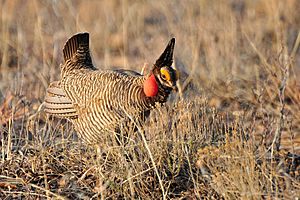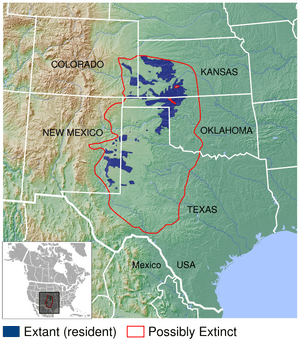Lesser prairie-chicken facts for kids
Quick facts for kids Lesser prairie-chicken |
|
|---|---|
 |
|
| A lesser prairie chicken in New Mexico | |
| Conservation status | |
| Scientific classification | |
| Genus: |
Tympanuchus
|
| Species: |
pallidicinctus
|
 |
|
| Lesser prairie-chicken range. | |
| Synonyms | |
|
Tympanuchus cupido pallidicinctus |
|
The lesser prairie-chicken (Tympanuchus pallidicinctus) is a species in the grouse family.
Contents
Description
It is a medium to large bird, striped white and brown, slightly smaller and paler than its near relative the greater prairie-chicken (T. cupido). Adults range from 15.0 to 16.1 inches (38 to 41 cm) in length and 22.1 to 28.7 ounces (630 to 810 g) in weight.
Distribution
About half of its current population lives in western Kansas, with the other half in the sandhills and prairies of western Oklahoma, the Texas Panhandle including the Llano Estacado, eastern New Mexico, and southeastern Colorado.
Behavior
Like its larger relative, it is known for its lekking behavior.
Conservation
Considered "vulnerable" by the IUCN due to its restricted and patchy range, it is vulnerable to habitat destruction. The lesser prairie-chicken's habitat has been reduced by 85%, and their population has declined by as much as 99% in some ecoregions as a result. Of the remaining patches of suitable habitat, only around 0.1% are sufficiently contiguous to sustain even a minimum population of the birds. There is evidence suggesting that global warming may have a particularly detrimental influence by greatly reducing the size of the sagebrush ecosystem. Subfossil remains are known, e.g., from Rocky Arroyo in the Guadalupe Mountains, outside the species' current range but where more habitat existed in the less humid conditions in the outgoing last ice age. Range contraction apparently took place no later than about 8000 BC.
Threatened and endangered species listings
On March 27, 2014, the lesser prairie-chicken was listed as threatened under the Endangered Species Act but the listing was vacated in 2015 following a legal challenge. On June 1, 2021, the US Fish and Wildlife Service (USFWS) proposed splitting the species into two segments. The northern one, covering Oklahoma, Colorado, Kansas, and a portion of Texas, would be listed as threatened, and the southern one, covering New Mexico and a portion of Texas, as endangered. On November 17, 2022, the USFWS published a final rule listing the Southern Distinct Population Segment (DPS) of the lesser prairie-chicken as endangered and the Northern DPS as threatened. Implementation of the rule was delayed, and it took effect on March 27, 2023.
In 2015, Senator Jerry Moran (R-Kan) introduced an amendment to legislation authorizing construction of the Keystone XL Pipeline that would overturn the listing. He disputed the listing as, "... another example of unnecessary intrusion into private lives and businesses by the federal government." His action was supported by the American Energy Alliance and opposed by the League of Conservation Voters.
When the Senate voted on the Keystone bill, it did not get the 60 votes in favor that was required to pass. It got only 53 Republican and one Democratic Senator to vote in favor.
The United States Department of the Interior proposed creating a lesser prairie-chicken preserve as a national monument, but action was never taken action on the proposal.
In May 2023, the U.S. Senate voted to strip the lesser prairie-chicken of its new listing using its authority under the Congressional Review Act. President Joe Biden's administration threatened to veto the bill if the House of Representatives passed it, which the House did on July 27. The bill was passed by the Senate, but vetoed by Biden on September 27, 2023.
See also
 In Spanish: Gallo de las praderas chico para niños
In Spanish: Gallo de las praderas chico para niños


